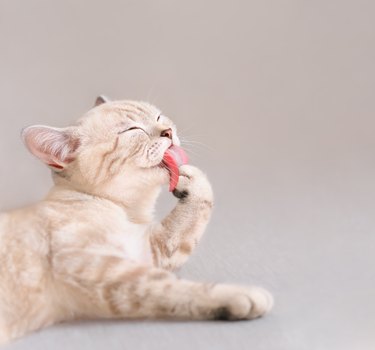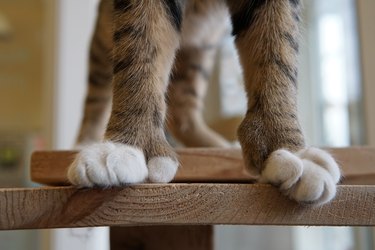A swollen cat paw can be a sign of an injury, a disease, a sting, a bite, or an infection. Your cat will likely protect the paw, lick it excessively, or avoid bearing weight on the painful foot. If your kitty will let you examine them, you may be able to identify the problem and implement basic care at home. However, cats in pain are prone to scratching, biting, and running, so veterinary attention is usually a necessity.

Video of the Day
Examining a cat paw injury
Injuries to cat paws can include an open wound, a sprained foot, a broken toe, or a dislocated toe. These generally affect only one paw or toe and may be noticeable if the cat is limping and holding one paw off the ground. Otherwise, gently hold the cat as you look for swelling, a wound, or an obvious dislocation. If you find a wound, try to gently wash it to stave off infection. When you call your veterinarian, be prepared to describe the injury you have found and whether swelling is present.
Video of the Day
Removing foreign objects from a cat's paw
If your cat has a sharp object lodged between their toes or embedded in their paw, it could lead to pain, swelling, and tenderness. You may notice a discharge or feel that the paw is warm to the touch, which are signs of infection that will likely require prescription antibiotic treatment. If you can safely remove small objects, such as pebbles or thorns, wash the paw and continue to monitor your cat's paw every morning and evening for discharge or debris until the foot has healed. If swelling persists, an object is deeply embedded, or you see signs of infection, seek a veterinarian's attention. Wounds that seem to heal but reopen later also require a trip to your veterinarian.

Stings, bites, and environmental injuries on cat paws
If your cat's paw is swollen, it can be a sign that your cat was stung by an insect or bitten by a rodent or other small animal. This can trigger a potential allergic reaction or lead to infection. Your cat may have come in contact with a toxic substance, such as a lawn chemical or cleaning product, that irritated their sensitive foot pads. If you think this is the case, gently wash the foot pad and seek medical attention. If your cat shows signs of allergic shock, such as vomiting, loss of bowel and bladder control, or respiratory distress, seek medical help right away.
Preventing and treating overgrown nail problems in cats
While regular scratching keeps most cat nails at a suitable length, overgrown cat claws that puncture paw pads can lead to infection and swelling, so veterinary attention is advised. Overgrown claws can also occur in less active senior cats or can be a sign of a chronic disease, so if this is a regular occurrence for your cat, talk to your vet about potential causes and treatment options.
Polydactyl cats, who have those adorable extra toes, can have one or more toenails growing directly out of the skin between two toes. These extra nails can also become overgrown and can puncture the skin. If your cat's nails tend to become overgrown and you are not comfortable trimming them, it is important to make a regular appointment with a professional who is experienced in trimming cats' nails.

Veterinarian diagnosis and treatment for cats
Your veterinarian may be able to determine the cause of your cat's paw swelling or tenderness through a physical exam. Sedation may be necessary if your pet is in pain or if X-rays and/or wound treatment are needed. Treatment options will vary based on the underlying cause of the swelling. Infections are often treated with antibiotics and anti-inflammatory and/or pain medications to reduce pain and swelling. Lacerations or certain other conditions may require surgical repair.
Continuing with home care for cats
If your pet had a small, open wound that didn't need stitches, your vet will instruct you on how to clean it as well as how often and with what. If your pet required surgery or if the wound was small enough to leave open, you might need to temporarily switch out your cat's regular clay or crystal litter with a fragrance-free, paper pellet litter. A pelleted litter can't get into the wound and has significantly less dust/particulate matter than clay litter. You may need to limit your cat's physical activity if they suffered a serious injury, such as a broken bone, or required surgery to treat their condition.